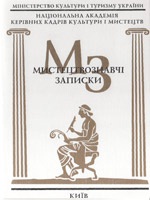Нові конотації в балетах «Весна священна» та художні прийоми «подвійного кодування» в мистецтві хореографії
New connotation in the ballet «The Rite of Spring» and the artistic techniques of «double coding» in the art of choreography
Author(s): Olena AphoninaSubject(s): Theatre, Dance, Performing Arts, Sociology of Art
Published by: Національна академія керівних кадрів культури і мистецтв
Keywords: code; double coding; connotation; ballet «The Rite of Spring» І. Stravinsky; M. Bejart; P. Bausch; R. Poklitaru;
Summary/Abstract: The purpose of the article is to expand range of connotations of the «spirit of antiquity» in the ballet «The Rite of Spring», staged by different choreographers from the point of view of post-modern concepts. Methodology. The research methodology includes using of the historical-comparative method to identify new connotations in the ballet «The Rite of Spring»; semiotic approach and deconstructivist analysis (Derrida) to describe the «double coding» in the art of «moving sculpture». Scientific Novelty. The scientific novelty of this work is to determine the new connotations of the «archaic» in Igor Stravinsky’s ballet, covering contemporary and postmodern interpretations at the level of the aesthetic content as well as dramatic ballets. Choreographic works as types of the text are viewed as an information transmission through the motorsemantic form, allusions and reminiscences. Conclusions. Music of Stravinsky and codes-images of pagan Russ are the main unchangeable code of each ballet (except R. Poklitaru’s ballet). V. Nijinsky’s staging is made in the spirit of the composer's music. It is the unity of music and choreography with the transfer of the main code-images. M. Bejart’s staging is saturated with allusions and reminiscences, as the methods of «double coding». They send the imagination of the audience to anthropogenesis with the evolutionary process of human origin. The content of P. Bausch’s ballet is close to the source, and the dancers’ movements represent the synthesis of dance techniques. In the ballet of R. Poklitaru allusions and reminiscences contain the basic codes-images, motifs and stylistic techniques.
Journal: Мистецтвознавчі записки
- Issue Year: 2017
- Issue No: 31
- Page Range: 280-288
- Page Count: 9
- Language: Ukrainian

